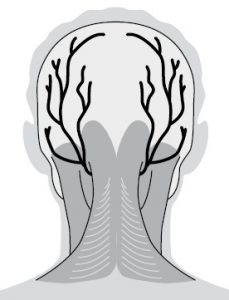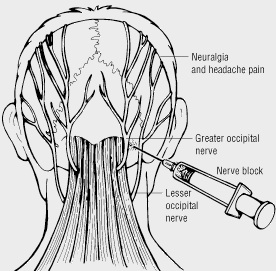What is an Occipital Nerve Block?
An occipital nerve block is an injection of numbing medicine next to the occipital nerves. There are occipital nerves on either side of the head, located just underneath the scalp on the back of the head. These are the greater and lesser occipital nerves. The greater occipital nerve provides sensation to the back and top part of the head. They can be a  source of headache pain and what is called occipital neuralgia.
source of headache pain and what is called occipital neuralgia.
Therefore, an occipital nerve block is designed to stop the pain sensation traveling through the occipital nerves. There are two occipital nerves, the greater and lesser. The injection is most often used to diagnose and treat cervicogenic headaches along with occipital neuralgia, and has also been shown to provide pain relief for migraine sufferers. So it has two purposes, including both a diagnostic one and a therapeutic one.
A significant amount of the time individuals experiencing occipital neuralgia also have arthritis and associated cervical pain coming from a problem in the neck. This may include arthritis in the facet joints of the neck. Therefore, patients will often require injections into the facet joints of the neck along with the occipital block for best results.
What are the Symptoms of Occipital Neuralgia?
Standard symptoms of occipital neuralgia include pain on one or both sides of the head, light sensitivity and a tender scalp, along with an aching, burning or throbbing pain. The patient sometimes describes it as being sharp or an electrical shock in the back part of the neck and head.
Who benefits from an occipital nerve block?
Those that benefit the most from an occipital nerve block include patients who have pain on one side of the head but mostly occuring at the back of the head. The pain may be described as shooting, burning or stinging pain. In addition, those who have migraines and cluster headaches often respond well to occipital nerve blocks including patients who have scalp tenderness at the base of the head.
As mentioned, patients with occipital neuralgia, cervicogenic headaches, and migraine headache sufferers often benefit from occipital nerve blocks.
How is the Occipital Block injection performed?
An occipital nerve block only takes a few minutes and is performed as an outpatient. It may actually be performed in an office setting or in a surgery center. Individuals do not need IV sedation for the procedure, and it may be performed with a simple local anesth etic such as lidocaine.
etic such as lidocaine.
Often times the pain management doctor will include steroid medication such as with Depo-Medrol or Celeston being added for additional pain relief. In order to achieve the most pain relief, pain doctors will often move the needle under the skin while injecting numbing medicine to block both of the patient’s occipital nerves (greater and lesser occipital nerves – see picture).
Call (602) 507 – 6550 to Get Started Today or

How quickly is pain relief achieved with an Occipital Block?
With the lidocaine being injected a patient typically receives pain relief within minutes. This numbing medicine may last multiple hours, and then wear off, or the numbing medicine may provide pain relief for weeks to months. The mechanism of how a simple numbing medicine may provide months of pain relief is poorly understood.
The steroid medication will hopefully allow for continued pain relief as well for the next few weeks to months.
If the pain relief wears off, what’s next?

If the pain returns, a radiofrequency ablation may provide over a year of pain relief.
It’s good results are achieved with the nerve block and the pain returns, there are a few options. The first is simply to repeat the injection. Another option is a more permanent type of procedure that involves a radiofrequency ablation of the occipital nerve.
Radiofrequency ablation is fairly new in pain management for headaches and has shown excellent results so far for the management of occipital neuralgia. The procedure is often referred to as radiofrequency neurotomy or radiofrequency lesioning as well. One other more permanent option is referred to as an occipital nerve stimulator. This can be extremely helpful and is also referred to as a nerve pacemaker.
How well does an Occipital Nerve Block work for headaches?
As mentioned, these injections have two purposes. The first is diagnostic. If the pain management doctor in Arizona performs an injection to block the greater and lesser occipital nerves and it works, then it is a reasonable assumption that the patient has occipital neuralgia. The second purpose is for therapeutic benefit. Often times multiple injections are needed to obtain the best results for individuals, so once the diagnostic injection shows satisfactory results then repeat injections can maximize pain relief.
Studies that have been performed looking at occipital nerve blocks have shown excellent reduction of symptoms with approximately 6 months of pain relief achieved. in order to achieve the six-month pain relief, multiple injections are typically required a few weeks apart.
What are the risks of the occipital block procedure?
The risks of a greater occipital nerve block are very low. There may be some bleeding, and since the scalp has a lot of blood supply to it one may need a pressure dressing and some ice to minimize this problem.
There is a risk of infection or an allergic reaction with the procedure. Individuals may sometimes have some facial flushing or a brief feeling of faintness. There is no chance of a cerebrospinal fluid leak or meningitis as the needle stays outside of the skull. The occipital nerves only have a sensory function so there is no risk of muscle weakness including no risk for changes in facial expression.

If you or a loved one is dealing with significant headaches in the back of the scalp on one or both sides, then Arizona Pain Specialists can help. The Arizona pain doctors are Board Certified and Fellowship Trained, and have performed thousands of Occipital Nerve Blocks.
Call (602) 507 – 6550 to Get Started Today or
